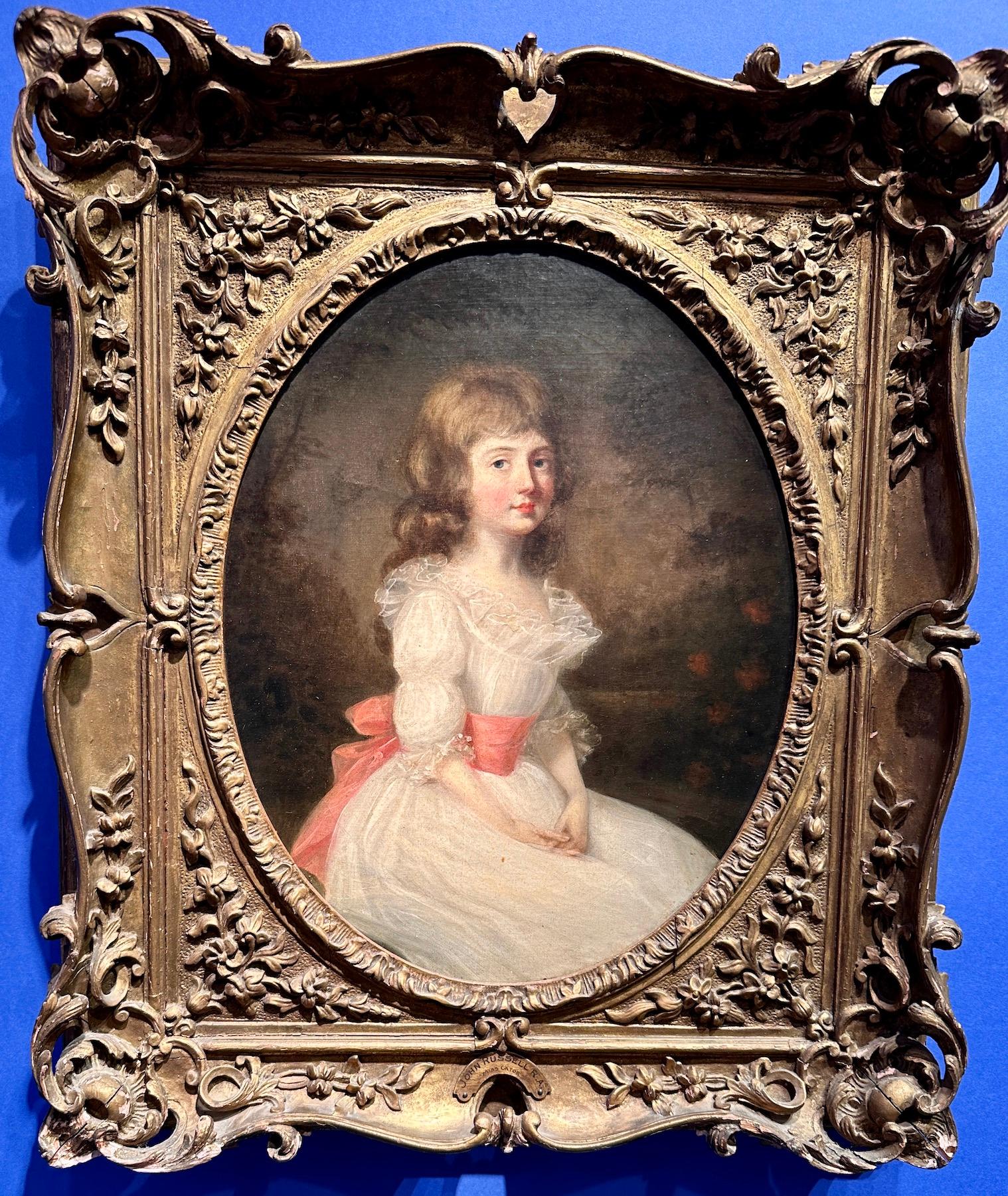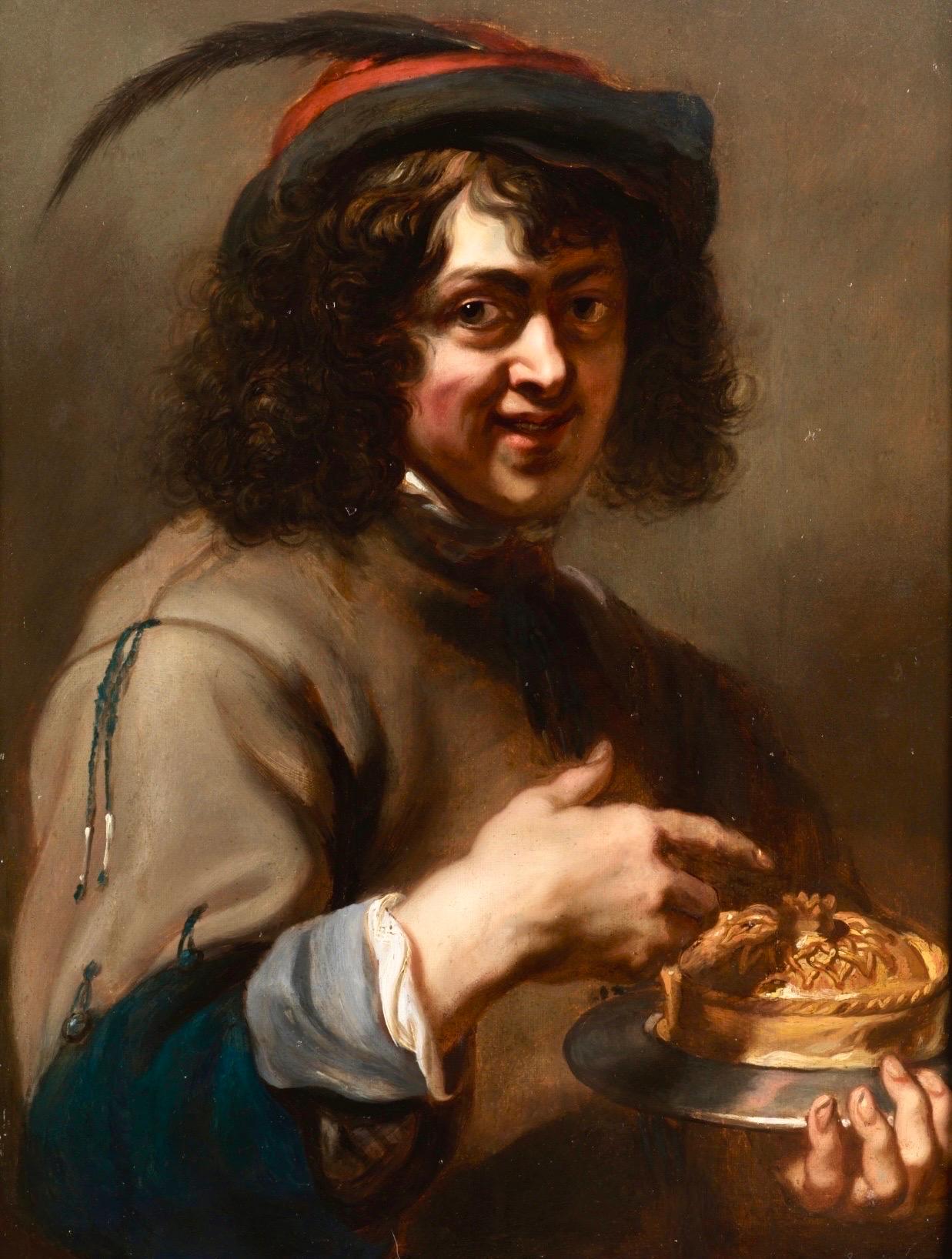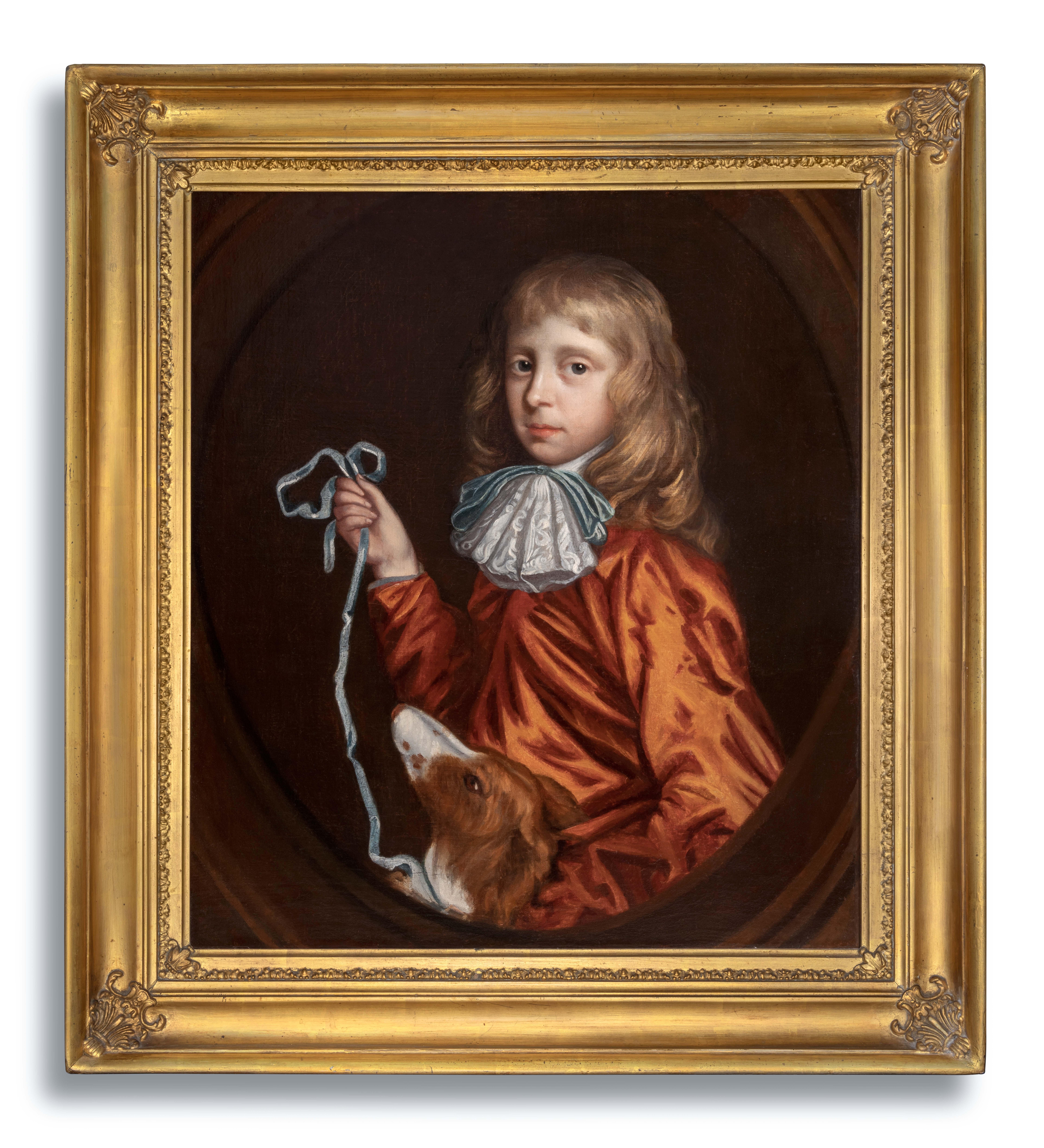Items Similar to 18th Century English School Portrait of a handsome young gentleman, half length
Want more images or videos?
Request additional images or videos from the seller
1 of 24
18th Century English School Portrait of a handsome young gentleman, half length
About the Item
A very skilfully captured portrait of a handsome young gentleman. The painter, in the circle of Sir Willliam Beechey, has imparted great character and vitality to the sitter, giving the young man a kindly expression that engages with the viewer. A handsome, large painting.
Circle of Sir William Beechey, late 18th century
Portrait of a young man, half-length
Oil on canvas
30½ x 25 inches without frame
38 x 33 inches with frame
Tha painting is unsigned but the style and format of the portrait, with the sitter set against a darkened background, very much recalls Sir William Beechey's portraits of the time.
Sir William Beechey was a successful portrait painter with unparalleled royal patronage. His intended legal career was cut short by a chance meeting with students of the Royal Academy Schools and in 1772 Beechey entered the schools himself. He first exhibited at the Royal Academy in 1776. After five years in Norwich, he moved back to London in 1787 where he stepped into the vacuum left by Gainsborough’s death and Reynolds’ retirement. He gained a reputation for straight-forward, unpretentious and careful portraiture and in 1793 he was appointed painter to Queen Charlotte. Not long afterwards he was made a member of the Royal Academy – on King George’s request, it was rumoured – but he fell from royal favour in 1806. He continued to exhibit at the Academy until the year before his death.
- Dimensions:Height: 30.5 in (77.47 cm)Width: 25 in (63.5 cm)Depth: 3 in (7.62 cm)
- Medium:
- Movement & Style:
- Circle Of:Sir William Beechey (1753 - 1839, British)
- Period:
- Condition:
- Gallery Location:Harkstead, GB
- Reference Number:1stDibs: LU1481213820032
About the Seller
5.0
Platinum Seller
These expertly vetted sellers are 1stDibs' most experienced sellers and are rated highest by our customers.
Established in 2002
1stDibs seller since 2021
110 sales on 1stDibs
Typical response time: 2 hours
- ShippingRetrieving quote...Ships From: Harkstead, United Kingdom
- Return PolicyA return for this item may be initiated within 7 days of delivery.
More From This SellerView All
- 18th Century English School Portrait of a young girl, half lengthLocated in Harkstead, GBA charming portrait of a young girl presented in the original, hand carved giltwood frame. Circle of John Opie (1761-1807) Portrait of a young girl, half length With old label to t...Category
18th Century Old Masters Portrait Paintings
MaterialsCanvas, Oil
- Portrait of a Welsh Miner from 1930s, Welsh ArtLocated in Harkstead, GBAn incredibly rare work by the artist dating to 1932. In subject matter, it brings to mind William Roberts but with a more linear and sculptural style. John Bromfield Gay Rees (1912-1965) Welsh miner Signed and dated '1932', inscribed with artist's address verso Oil on canvas 18½ x 9½ inches without frame 23 x 14 inches with frame John Bromfield Gay Rees (1912 - 1965), known to his family and friends as Brom, was a Welsh painter whose work was admired by such eminent figures as Dylan Thomas, Augustus John, William Rothenstein and Eardley Knollys...Category
Early 20th Century Modern Portrait Paintings
MaterialsOil, Canvas
- Very Large Full length portrait of a young lady with a posy of flowersLocated in Harkstead, GBA very engaging portrait of a pretty young girl holding a posy of flowers. On a large scale, this impressive piece would add grandeur to a hall or drawing room. William Edwards Mill...Category
Late 19th Century Victorian Portrait Paintings
MaterialsCanvas, Oil
- Female Cornish artist, Walter Sickert pupil, Cubist portrait of man in interiorLocated in Harkstead, GBA really stylish portrait of a young man relaxing in an interior, painted in a unique, almost cubist style and wonderful texture to the brushwork. Garlick Barnes ( 1891-1987) A man reading in an interior Signed Oil on canvas 24 x 20 inches without frame 29 x 24½ inches with frame Barnes raised four children before turning her full attention to art. She studied at the Sidney Cooper School of Art, Canterbury, and at Heatherley's. In 1936 Garlick became a pupil of Walter Richard SICKERT...Category
20th Century Modern Interior Paintings
MaterialsCanvas, Oil
- 1980s Erotic nude male portrait of artist's lover, Iconic piece from gay historyLocated in Harkstead, GBThis incredibly striking portrait, painted in a fiery palette captures an intimate moment between the artist and sitter who were lovers. Philip Core (1951-1989) Portrait of Adrian Ffooks, 4th/7th regiment Signed and dated 1987 to the reverse Oil on board 30 x 17¾ inches without the frame 35 x 23 inches with the frame Provenance: Gifted as a wedding present to Kit Hesketh-Harvey by his future wife. The artist was a friend of the couple and they had introduced Core to FFooks. Kit Hesketh Harvey co-wrote the screenplay (with James Ivory) for E.M.Forster’s Maurice and he had called upon Ffooks, who was renowned for his horsemanship, to be a stunt double for the equestrian scenes in this iconic film. Philp Core grew up in New Orleans, the son of a well-to-do family. At just seven he won the Vieux Carré Open Artists Competition. He was sent to a military academy, and from 1963 to the Middlesex School in Concord, Massachusetts. He attended Harvard University, where he won a number of art and literature prizes. As a schoolboy he self-published a booklet of drawings Palm Fronde Alphabet. An interest in Aubrey Beardsley and fin de siècle artists and writers, led to him spending time in Paris working with Philippe Jullian on his book The Symbolists, before returning to Harvard to complete an honours thesis on Belgian symbolist Fernand Khnopff. He graduated in 1973. Under the pseudonym Féllippé Fecit, he produced a series of erotic drawings for the poet John Glassco for his book Squire Hardman, and in 1968 in the Japanese style for The Temple of Pederasty, a free adaption by Glassco of a work by Japanese expatriate writer Ken Sato. Of this time, George Melly...Category
1980s Modern Nude Paintings
MaterialsBoard, Oil
- Frederick Frith mid 19th Century English Victorian silhouette portraitLocated in Harkstead, GBA finely detailed silhouette of a Victorian clergyman. Frederick Frith (1819-1871) The Reverend James Metze, bust length, turned to the right, wearing coat and cravat Inscribed to t...Category
Mid-19th Century English School Portrait Drawings and Watercolors
MaterialsWatercolor, Paper
You May Also Like
- English Portraits of Lady, Dorothy & Jane Wood c.1750, Remarkable Carved FramesBy John Theodore HeinsLocated in London, GBPortraits of a Lady, Dorothy and Jane Wood c.1750, Fine Carved Frames By John Theodore Heins (1697-1756) Titan Fine Art present these works, which formed part of a collection of family heirlooms of the Wood family who were from Bracon Ash, Norfolk, since the medieval period. Jane’s daughter Ann, was famously married on board the Foudroyant, off Naples, in a lavish ceremony in 1799, with Lord Nelson himself giving away the bride. The paintings descended within the family for around 275 years until recent and are exquisite examples of Georgian portraiture in England and are some of the best works by the artist. The original hand carved and gilded pierced frames are magnificent works of art in their own right. The sitters were two children, out of several, of Thomas Wood (1682-176) and Dorothy Huby (1700-1759). The family is from Norwich, which in 1720 was a city second in importance only to London. Their aunt, Jane Wood (1677-1756), was a Franciscan nun in Bruges. Dorothy Wood (in the blue dress) was baptised 2nd June 1726 and she died unmarried around 1759. Jane (in the pink dress) gave birth to at least six children during her thirty two-year marriage. She was baptised 14 Oct 1727 at Bracon Ash. Jane married Knipe Gobbet (1730/5-1791) who was Sheriff in 1768 (and Mayor in 1771) of the City of Norwich, and later Lieutenant-Colonel of the West Norfolk Regiment, in which corps he had served in for many years. According to Payne’s Universal Chronicle or Weekly Gazette the marriage took place on 7th July 1758. Knipe was born at his family seat, Tacolneston Hall, to parents George Gobbet, who was Sheriff in 1710, and Ann. The couple bought and lived in a house in Norwich (later known as Gurney’s Bank House) until 1778 before moving to another one at 10 St Stephen’s Street, Norwich. Later, they inherited the family seat of Tacolnestan Hall and lived there for the remainder of their lives. Knipe Gobbet was a prominent individual and in 1779 he gave the corporation of Norwich 100 pounds, to be disposed of as they might think proper, and soon after that he was presented with a handsome field tent, marquee, and camp equipage, in testimony of their esteem for his dedication to the defence and service of this country at a time when threatened by an invasion. Although Jane was baptised a Roman Catholic Knipe was a prominent local wine merchant, JP, Alderman, sheriff, mayor and Lieutenant. Roman Catholics may have paid lip service to religious conformity as they were excluded from certain areas of public life before the Catholic Emancipation Act of 1829. Such discrimination probably lies behind the why their children are included in the registers of both the Anglican church in Tacolneston and the Norwich Catholic church in the 1760s. Jane and Knipe had one son, Thomas, who died at the age of four of a small-pox inoculation in 1762 (memorial stones in the Church of All Saints, Tacolneston) and many daughters who were schooled at the Order of the Immaculate Conception of Our Lady, in Paris. Their oldest daughter, Anne (1760-1817) was born at Tacolneston Hall. She came to the convent 30 Sept 1774 and ten days later she went to Dames St Sacrament, Rue St Louis in Paris. Their second daughter, Dorothy (died suddenly of apoplexy 21st Nov 1813), came to the convent 19th July 1777 when she was 16 years old and returned to England 23 March 1779. Frances (baptised 22 Feb 1763) came to the convent 16th April 1772 when she was 9 years old and returned 29th May 1777 – however she returned again to the convent 16th May 1778 and left 15th Oct 1778 to return home again. She later married and her surname became Negri. Another daughter, Jane, is thought to have married Juan Manuel Martinez in 1784. There was also another daughter, Mary. The eldest daughter, Ann, first married Peter Bottalini of London 27 Oct 1783 at Tacolneston Hall. They had one son together. She then married on 9th July 1799, Dr William Compton (1733- Clifton 1824), the Chancellor of Ely and the next collateral male relation to the Earl of Northampton (he had earlier marriages to Caroline and Catherine). William Compton later retired from the Commons and spent many years on the continent acting as Chancellor of Ely by proxy from 1777 for the remainder of his life. The couple were British residents of Posilipo Naples and the marriage was hosted on board the Foudroyant, off Naples, where the bride was given away by the Right Hon. Lord Nelson himself. The marriage document, signed by Lord Nelson, Lady Emma Hamilton, Captain Thomas Hardy, and others descended within the family, until sold in a sale that raised worldwide interest in 2023, for £20,160. The document is accompanied by a contemporary manuscript account of the wedding, headed 'Paragraph for the papers, sent to Messrs Coutts & Co with request to have it inserted'. Lord Nelson was a household name in Britain due to his many victories, including the Battle of the Nile against the French Navy in August 1798 – which came before the Battle of Trafalgar in 1805. The document states: 'This is to certify that, on board the Foudroyant lying in Naples Bay, on the ninth of July 1799 the marriage between William Compton & Mrs Anne Bottalin, widow, was solemnized by me S. G. Comyn HM. Chaplain to the Right Honble Lord Nelson, H.M.S. Foudroyant, in the presence of'. With the following autograph signatures: Sir William Hamilton (1731-1803), Lady Emma Hamilton (1765-1815), Horatio Nelson, Viscount Nelson (1758-1805); Sir John Thomas Duckworth (1747-1817), Sir Thomas Masterman Hardy (1769-1839), John Rushout, 2nd Baron Northwick (1769-1859), Josiah Nisbet (1780-1830), John Tyson, William Compton and Anne Bottalin, and 2 others” The document sheds light on Nelson's lesser-known side of his character. William Compton ... received "a great many favours and kindnesses" from Nelson, and most especially "the kind interest" taken in sealing his union with a wife who made him "the happiest of mortals". Anne, the aforesaid spouse, said that the admiral's "good heart" had made her "as happy as I can possibly be on this earth" ... Midshipman Parsons remembered those days nostalgically, noting Emma's "graceful form" bending over her harp to bestow "heavenly music" upon the diners on the quarterdeck and the large-decked galley, flush with opera singers, that glided alongside to serenade the sunset of each day'. Tacolneston has an ancient history of which according to the Domesday Book, Edward I granted a weekly market to be held on a Wednesday at the manor of Tacolneston and two annual fairs. The church was rebuilt in 1503 and is dedicated to All Saints. The earliest view of Tacolneston is a print of 1781 when it belonged to Knipe Gobbet Esq. John Theodore Heins (1697-1756) was a painter whose work, at his best, shows detail of an exceptionally high quality. His portraits of Anna Maria Kett nee Phillips and her husband Henry Kett, painted in 1741, are exceptional and evidence that he had the ability to portray a likeness on par with some of the best portraitists in England at the time. Heins appears to have originated in Germany but moved to the UK and settled in Norwich around 1720. From 1720 to his death in 1756, Heins built up a fine reputation as a portrait painter and painted many members of prominent Norfolk families right up to his last year. He was commissioned in 1732 to paint a portrait of the Mayor of Norwich, Francis Arnam and also the previous year's Mayor Robert Marsh...Category
18th Century Old Masters Portrait Paintings
MaterialsCanvas, Oil
- 18th century Portrait of a young girl, Miss Cator in a landscape, white dressBy John RussellLocated in Woodbury, CTPortrait of a young British Girl, in her white dress with Pink Sash. Choosing to acquire an 18th-century portrait of a young girl by English artist John Russell is an opportunity to...Category
1780s Old Masters Portrait Paintings
MaterialsCanvas, Oil
- 17th century Flemish Old Master - A young boy enjoying a pie, allegory of tasteLocated in Antwerp, BE17th century Flemish old master painting, Allegory of taste The very fine painting depicts a young boy, cheekily tasting a delicious pie. He's looking at the viewer with eyes twinkl...Category
17th Century Old Masters Figurative Paintings
MaterialsCanvas, Oil
- Portrait of a Young Gentleman and Pet Dog c.1680, Antique oil on Canvas PaintingBy (Circle of) Mary BealeLocated in London, GBThe portrait genre was valued particularly highly in English society. Neither landscapes nor allegorical pictures were ever priced so highly at exhibitions and in the trade as depictions of people, from the highest aristocracy to scholars, writers, poets and statesmen. This charming portrait, presented by Titan Fine Art, of a fashionable young gentleman and his faithful pet is an excellent example of 17th century child portraiture in England. There is a remarkable beauty and sensitivity to the portrait. The face, particularly well rendered, has captured the character of this young man – both charming and at the same time mischievous. Only the playful attention of a small dog suggests anything less than patrician dignity. Symbolism was important in portraiture and it provided a pointed and aspirational narrative that would not have been lost on contemporary viewers. For example, the presence of the dog, which was likely the boy’s pet, is at once a charming pictorial device and also a clear allusion to fidelity, trust and loyalty. The hairstyle and the attire, notably the type of cravat with the blue ribbon, help to date this portrait to between 1670 to 1685. Until the late eighteenth century children were dressed as adults - boys were dressed like men in breeches, vests, and coats between four and seven years of age. The expensive lace is an indication to his family’s wealth. Held in a good quality and condition antique gilded frame. Born in Suffolk, Mary Beale, nee Cradock (1633-1699) was employed by many of the most distinguished persons of her time including nobility, landed gentry, and clergymen. Technically accomplished, her paintings are noteworthy for their honest and sympathetic portrayal. In 1651 she married Charles Beale...Category
17th Century Old Masters Portrait Paintings
MaterialsCanvas, Oil
- 17th century Dutch portrait of a Lady in Red adorned with PearlsBy Pieter NasonLocated in Bath, SomersetPortrait of a lady, half-length in a feigned oval wearing a ruby coloured silk gown holding entwined strings of pearls across her bodice. Signed 'PNason' and dated 1667 (lower right)...Category
17th Century Old Masters Portrait Paintings
MaterialsOil, Canvas
- Portrait of Frances Lady Whitmore nee Brooke, Exquisite Carved Frame, Old MasterBy Sir Peter LelyLocated in London, GBPortrait of Frances, Lady Whitmore nee Brooke (c.1638-1690) Circle of Sir Peter Lely (1618-1680) Titan Fine Art presents this exquisite portrait that depicts Frances Brooke, Lady Wh...Category
17th Century Old Masters Portrait Paintings
MaterialsCanvas, Oil
Recently Viewed
View AllMore Ways To Browse
Antique Portrait 18th
Handsome Art
18th Century English Painting
Old English 18th Century
18th Century English Portrait
English Portraits 18th
Antique 18th Century English Frames
English 18th Century Portrait Paintings
Painting Handsome
Gentleman Set
English Gentleman
Very Large 18th Century Paintings
Painting Old Unsigned
Handsome Oil
18th Century Portrait Man
18th Century Portrait Of Man
Handsome Man
English King Set





